Business Law Report
VerifiedAdded on 2020/12/24
|12
|3375
|135
Report
AI Summary
This report examines the English legal system, its impact on business, and various dispute resolution alternatives. It analyzes the case of Pimlico Plumbers v Smith to determine the employment status of a delivery boy for a fictional company, KANGO. The report also examines different forms of business organizations, including private limited companies, partnerships, and sole traders, highlighting their advantages and disadvantages. Finally, it provides practical advice on resolving disputes through negotiation, arbitration, mediation, and ombudsman services.
Contribute Materials
Your contribution can guide someone’s learning journey. Share your
documents today.

Business law
Secure Best Marks with AI Grader
Need help grading? Try our AI Grader for instant feedback on your assignments.

Table of Contents
INTRODUCTION...........................................................................................................................1
TASK 1............................................................................................................................................1
TASK 2............................................................................................................................................3
TASK 3............................................................................................................................................5
TASK 4............................................................................................................................................7
CONCLUSION................................................................................................................................9
REFERENCES-.............................................................................................................................10
INTRODUCTION...........................................................................................................................1
TASK 1............................................................................................................................................1
TASK 2............................................................................................................................................3
TASK 3............................................................................................................................................5
TASK 4............................................................................................................................................7
CONCLUSION................................................................................................................................9
REFERENCES-.............................................................................................................................10
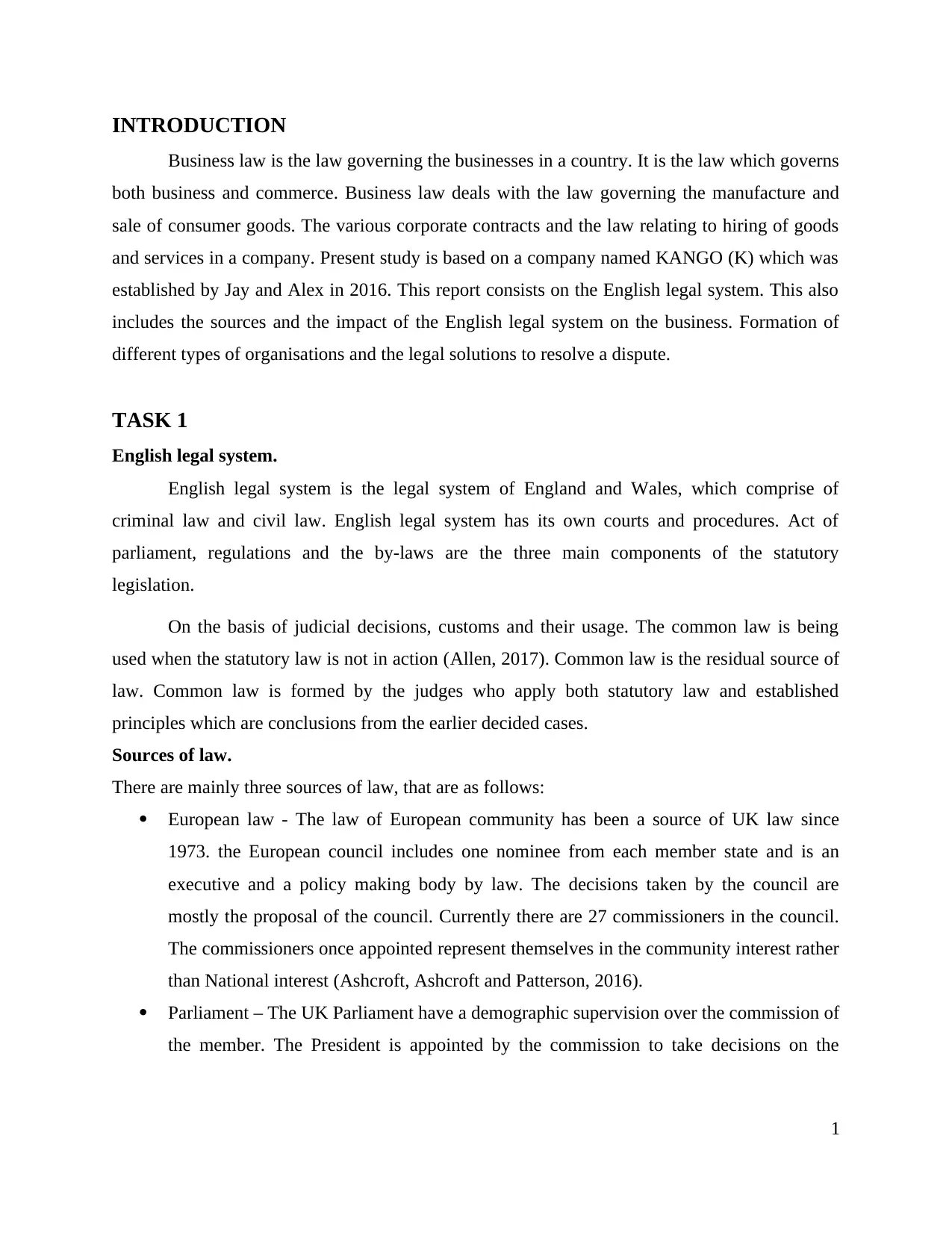
INTRODUCTION
Business law is the law governing the businesses in a country. It is the law which governs
both business and commerce. Business law deals with the law governing the manufacture and
sale of consumer goods. The various corporate contracts and the law relating to hiring of goods
and services in a company. Present study is based on a company named KANGO (K) which was
established by Jay and Alex in 2016. This report consists on the English legal system. This also
includes the sources and the impact of the English legal system on the business. Formation of
different types of organisations and the legal solutions to resolve a dispute.
TASK 1
English legal system.
English legal system is the legal system of England and Wales, which comprise of
criminal law and civil law. English legal system has its own courts and procedures. Act of
parliament, regulations and the by-laws are the three main components of the statutory
legislation.
On the basis of judicial decisions, customs and their usage. The common law is being
used when the statutory law is not in action (Allen, 2017). Common law is the residual source of
law. Common law is formed by the judges who apply both statutory law and established
principles which are conclusions from the earlier decided cases.
Sources of law.
There are mainly three sources of law, that are as follows:
European law - The law of European community has been a source of UK law since
1973. the European council includes one nominee from each member state and is an
executive and a policy making body by law. The decisions taken by the council are
mostly the proposal of the council. Currently there are 27 commissioners in the council.
The commissioners once appointed represent themselves in the community interest rather
than National interest (Ashcroft, Ashcroft and Patterson, 2016).
Parliament – The UK Parliament have a demographic supervision over the commission of
the member. The President is appointed by the commission to take decisions on the
1
Business law is the law governing the businesses in a country. It is the law which governs
both business and commerce. Business law deals with the law governing the manufacture and
sale of consumer goods. The various corporate contracts and the law relating to hiring of goods
and services in a company. Present study is based on a company named KANGO (K) which was
established by Jay and Alex in 2016. This report consists on the English legal system. This also
includes the sources and the impact of the English legal system on the business. Formation of
different types of organisations and the legal solutions to resolve a dispute.
TASK 1
English legal system.
English legal system is the legal system of England and Wales, which comprise of
criminal law and civil law. English legal system has its own courts and procedures. Act of
parliament, regulations and the by-laws are the three main components of the statutory
legislation.
On the basis of judicial decisions, customs and their usage. The common law is being
used when the statutory law is not in action (Allen, 2017). Common law is the residual source of
law. Common law is formed by the judges who apply both statutory law and established
principles which are conclusions from the earlier decided cases.
Sources of law.
There are mainly three sources of law, that are as follows:
European law - The law of European community has been a source of UK law since
1973. the European council includes one nominee from each member state and is an
executive and a policy making body by law. The decisions taken by the council are
mostly the proposal of the council. Currently there are 27 commissioners in the council.
The commissioners once appointed represent themselves in the community interest rather
than National interest (Ashcroft, Ashcroft and Patterson, 2016).
Parliament – The UK Parliament have a demographic supervision over the commission of
the member. The President is appointed by the commission to take decisions on the
1
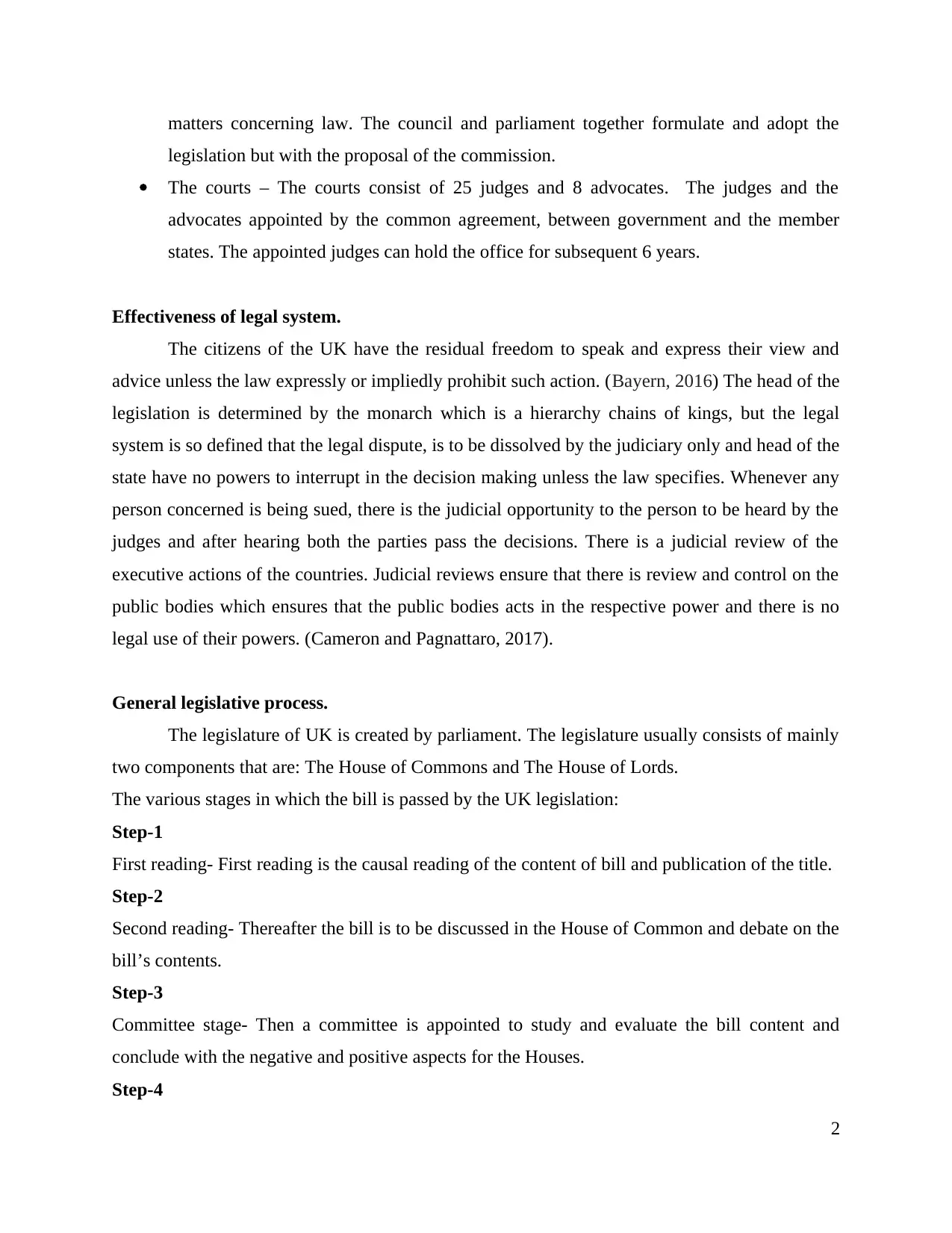
matters concerning law. The council and parliament together formulate and adopt the
legislation but with the proposal of the commission.
The courts – The courts consist of 25 judges and 8 advocates. The judges and the
advocates appointed by the common agreement, between government and the member
states. The appointed judges can hold the office for subsequent 6 years.
Effectiveness of legal system.
The citizens of the UK have the residual freedom to speak and express their view and
advice unless the law expressly or impliedly prohibit such action. (Bayern, 2016) The head of the
legislation is determined by the monarch which is a hierarchy chains of kings, but the legal
system is so defined that the legal dispute, is to be dissolved by the judiciary only and head of the
state have no powers to interrupt in the decision making unless the law specifies. Whenever any
person concerned is being sued, there is the judicial opportunity to the person to be heard by the
judges and after hearing both the parties pass the decisions. There is a judicial review of the
executive actions of the countries. Judicial reviews ensure that there is review and control on the
public bodies which ensures that the public bodies acts in the respective power and there is no
legal use of their powers. (Cameron and Pagnattaro, 2017).
General legislative process.
The legislature of UK is created by parliament. The legislature usually consists of mainly
two components that are: The House of Commons and The House of Lords.
The various stages in which the bill is passed by the UK legislation:
Step-1
First reading- First reading is the causal reading of the content of bill and publication of the title.
Step-2
Second reading- Thereafter the bill is to be discussed in the House of Common and debate on the
bill’s contents.
Step-3
Committee stage- Then a committee is appointed to study and evaluate the bill content and
conclude with the negative and positive aspects for the Houses.
Step-4
2
legislation but with the proposal of the commission.
The courts – The courts consist of 25 judges and 8 advocates. The judges and the
advocates appointed by the common agreement, between government and the member
states. The appointed judges can hold the office for subsequent 6 years.
Effectiveness of legal system.
The citizens of the UK have the residual freedom to speak and express their view and
advice unless the law expressly or impliedly prohibit such action. (Bayern, 2016) The head of the
legislation is determined by the monarch which is a hierarchy chains of kings, but the legal
system is so defined that the legal dispute, is to be dissolved by the judiciary only and head of the
state have no powers to interrupt in the decision making unless the law specifies. Whenever any
person concerned is being sued, there is the judicial opportunity to the person to be heard by the
judges and after hearing both the parties pass the decisions. There is a judicial review of the
executive actions of the countries. Judicial reviews ensure that there is review and control on the
public bodies which ensures that the public bodies acts in the respective power and there is no
legal use of their powers. (Cameron and Pagnattaro, 2017).
General legislative process.
The legislature of UK is created by parliament. The legislature usually consists of mainly
two components that are: The House of Commons and The House of Lords.
The various stages in which the bill is passed by the UK legislation:
Step-1
First reading- First reading is the causal reading of the content of bill and publication of the title.
Step-2
Second reading- Thereafter the bill is to be discussed in the House of Common and debate on the
bill’s contents.
Step-3
Committee stage- Then a committee is appointed to study and evaluate the bill content and
conclude with the negative and positive aspects for the Houses.
Step-4
2
Secure Best Marks with AI Grader
Need help grading? Try our AI Grader for instant feedback on your assignments.
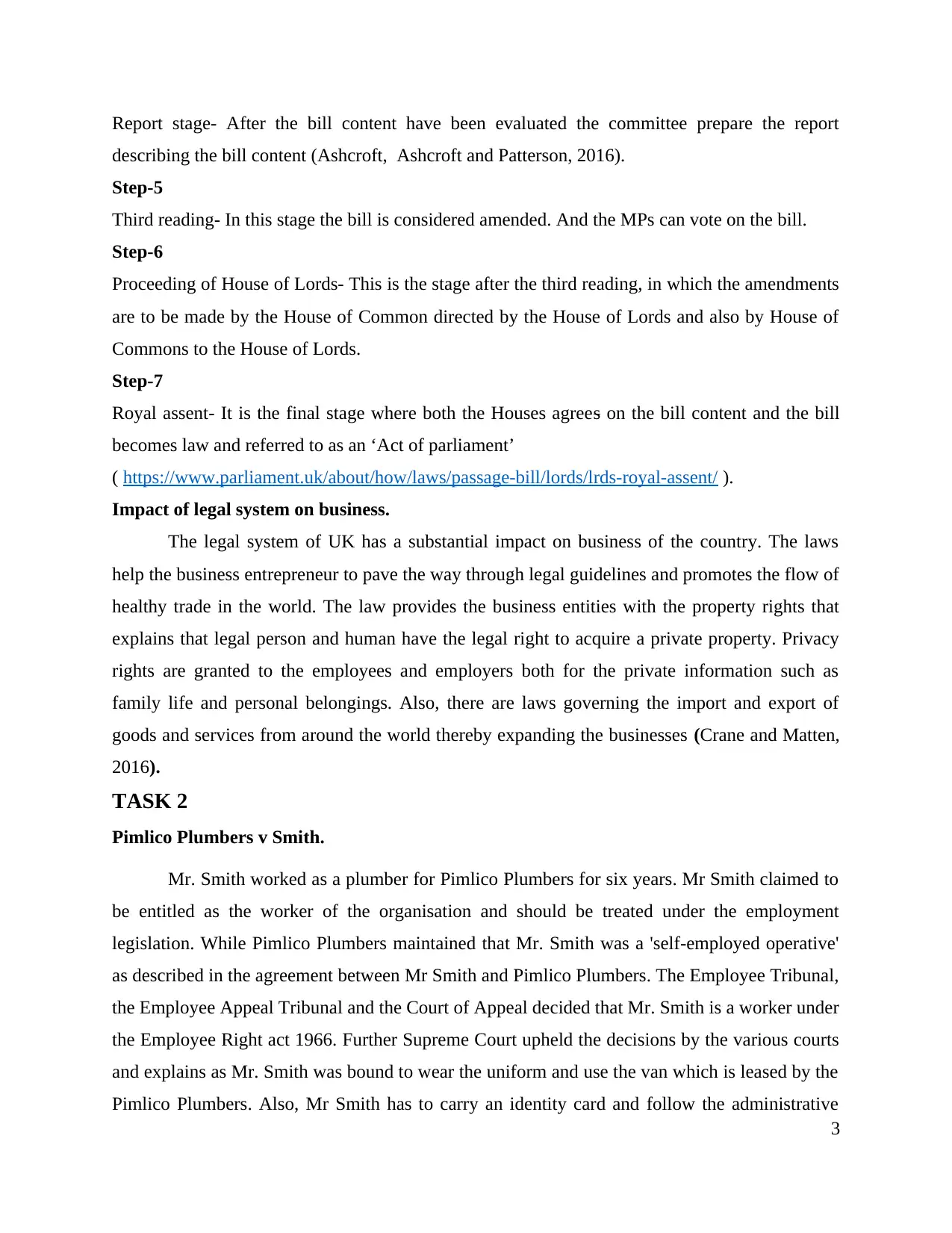
Report stage- After the bill content have been evaluated the committee prepare the report
describing the bill content (Ashcroft, Ashcroft and Patterson, 2016).
Step-5
Third reading- In this stage the bill is considered amended. And the MPs can vote on the bill.
Step-6
Proceeding of House of Lords- This is the stage after the third reading, in which the amendments
are to be made by the House of Common directed by the House of Lords and also by House of
Commons to the House of Lords.
Step-7
Royal assent- It is the final stage where both the Houses agrees on the bill content and the bill
becomes law and referred to as an ‘Act of parliament’
( https://www.parliament.uk/about/how/laws/passage-bill/lords/lrds-royal-assent/ ).
Impact of legal system on business.
The legal system of UK has a substantial impact on business of the country. The laws
help the business entrepreneur to pave the way through legal guidelines and promotes the flow of
healthy trade in the world. The law provides the business entities with the property rights that
explains that legal person and human have the legal right to acquire a private property. Privacy
rights are granted to the employees and employers both for the private information such as
family life and personal belongings. Also, there are laws governing the import and export of
goods and services from around the world thereby expanding the businesses (Crane and Matten,
2016).
TASK 2
Pimlico Plumbers v Smith.
Mr. Smith worked as a plumber for Pimlico Plumbers for six years. Mr Smith claimed to
be entitled as the worker of the organisation and should be treated under the employment
legislation. While Pimlico Plumbers maintained that Mr. Smith was a 'self-employed operative'
as described in the agreement between Mr Smith and Pimlico Plumbers. The Employee Tribunal,
the Employee Appeal Tribunal and the Court of Appeal decided that Mr. Smith is a worker under
the Employee Right act 1966. Further Supreme Court upheld the decisions by the various courts
and explains as Mr. Smith was bound to wear the uniform and use the van which is leased by the
Pimlico Plumbers. Also, Mr Smith has to carry an identity card and follow the administrative
3
describing the bill content (Ashcroft, Ashcroft and Patterson, 2016).
Step-5
Third reading- In this stage the bill is considered amended. And the MPs can vote on the bill.
Step-6
Proceeding of House of Lords- This is the stage after the third reading, in which the amendments
are to be made by the House of Common directed by the House of Lords and also by House of
Commons to the House of Lords.
Step-7
Royal assent- It is the final stage where both the Houses agrees on the bill content and the bill
becomes law and referred to as an ‘Act of parliament’
( https://www.parliament.uk/about/how/laws/passage-bill/lords/lrds-royal-assent/ ).
Impact of legal system on business.
The legal system of UK has a substantial impact on business of the country. The laws
help the business entrepreneur to pave the way through legal guidelines and promotes the flow of
healthy trade in the world. The law provides the business entities with the property rights that
explains that legal person and human have the legal right to acquire a private property. Privacy
rights are granted to the employees and employers both for the private information such as
family life and personal belongings. Also, there are laws governing the import and export of
goods and services from around the world thereby expanding the businesses (Crane and Matten,
2016).
TASK 2
Pimlico Plumbers v Smith.
Mr. Smith worked as a plumber for Pimlico Plumbers for six years. Mr Smith claimed to
be entitled as the worker of the organisation and should be treated under the employment
legislation. While Pimlico Plumbers maintained that Mr. Smith was a 'self-employed operative'
as described in the agreement between Mr Smith and Pimlico Plumbers. The Employee Tribunal,
the Employee Appeal Tribunal and the Court of Appeal decided that Mr. Smith is a worker under
the Employee Right act 1966. Further Supreme Court upheld the decisions by the various courts
and explains as Mr. Smith was bound to wear the uniform and use the van which is leased by the
Pimlico Plumbers. Also, Mr Smith has to carry an identity card and follow the administrative
3

rules. Thus the supreme court entitles Mr Smith to discrimination against wages, disability
period wages and any unlawful deduction of the holiday pay against him (Ashcroft, Ashcroft
and Patterson, 2016).
Employment status of delivery boy of KANGO.
In the case of the company KANGO, the delivery boy is bound to ride bicycle of brand
colour of KANGO. Also, delivery person has to wear the uniform allotted to him by the
company. With this the company have tight control over leave of the delivery man, he has to
inform 48 hours prior, to take leave and also it is regulated by the company. All the control and
substitution of the delivery boy is in the hands of the KANGO and the delivery man has no rights
over this.
As per the decision of the case of delivery man, is entitled to be the employee of the
company and enjoys all the rights attached to the job assigned and as he would be the company
employee under the Employee Rights Act 1996. He is entitled to the benefits of disablement
period the pension scheme, provident fund scheme etc. as applicable to him (Persadie and
Ramlogan, 2015).
Determining Employment Status.
A person is entitled to be an employee under the contract of service if he satisfies the
following conditions:
Employee works at the conditions specified by the employer. The employees have to
strictly follow the rules and regulations provided by the employer.
The employee does not have control over the work. Employer allots the work to the
employee and employee has to complete the work in the stimulated time given to him.
The employer provides the tools and techniques to the employee for work. The tools
include the basic objects to do the work given, the machinery and the complementary
items needed to perform the work.
Employee is entitled with the pension benefits, provident fund benefits, sick pays and
retirement benefits. Also, the disablement period expenses, workmen compensation
bonus and other benefits to be provided by the employer (Mikami, 2016).
4
period wages and any unlawful deduction of the holiday pay against him (Ashcroft, Ashcroft
and Patterson, 2016).
Employment status of delivery boy of KANGO.
In the case of the company KANGO, the delivery boy is bound to ride bicycle of brand
colour of KANGO. Also, delivery person has to wear the uniform allotted to him by the
company. With this the company have tight control over leave of the delivery man, he has to
inform 48 hours prior, to take leave and also it is regulated by the company. All the control and
substitution of the delivery boy is in the hands of the KANGO and the delivery man has no rights
over this.
As per the decision of the case of delivery man, is entitled to be the employee of the
company and enjoys all the rights attached to the job assigned and as he would be the company
employee under the Employee Rights Act 1996. He is entitled to the benefits of disablement
period the pension scheme, provident fund scheme etc. as applicable to him (Persadie and
Ramlogan, 2015).
Determining Employment Status.
A person is entitled to be an employee under the contract of service if he satisfies the
following conditions:
Employee works at the conditions specified by the employer. The employees have to
strictly follow the rules and regulations provided by the employer.
The employee does not have control over the work. Employer allots the work to the
employee and employee has to complete the work in the stimulated time given to him.
The employer provides the tools and techniques to the employee for work. The tools
include the basic objects to do the work given, the machinery and the complementary
items needed to perform the work.
Employee is entitled with the pension benefits, provident fund benefits, sick pays and
retirement benefits. Also, the disablement period expenses, workmen compensation
bonus and other benefits to be provided by the employer (Mikami, 2016).
4
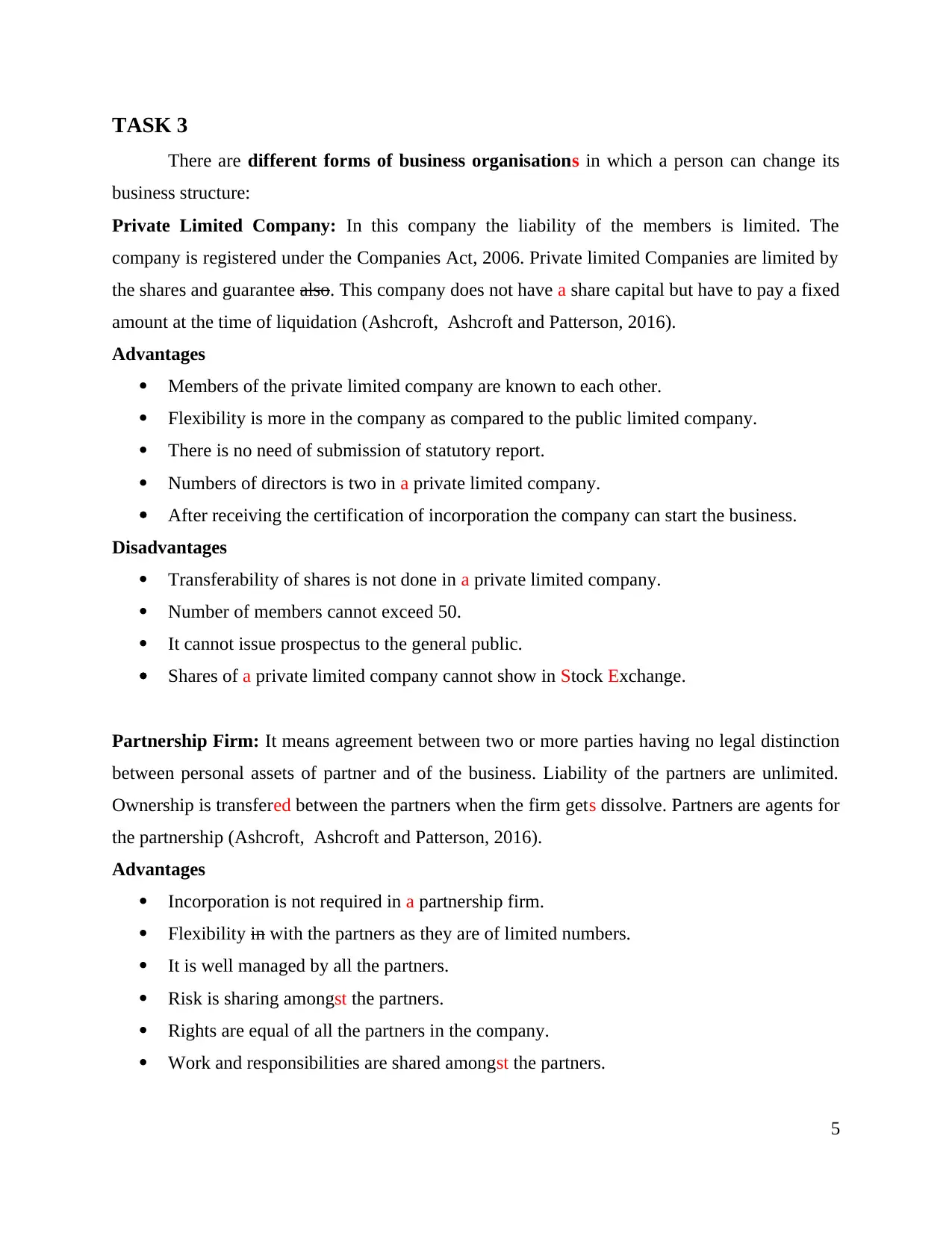
TASK 3
There are different forms of business organisations in which a person can change its
business structure:
Private Limited Company: In this company the liability of the members is limited. The
company is registered under the Companies Act, 2006. Private limited Companies are limited by
the shares and guarantee also. This company does not have a share capital but have to pay a fixed
amount at the time of liquidation (Ashcroft, Ashcroft and Patterson, 2016).
Advantages
Members of the private limited company are known to each other.
Flexibility is more in the company as compared to the public limited company.
There is no need of submission of statutory report.
Numbers of directors is two in a private limited company.
After receiving the certification of incorporation the company can start the business.
Disadvantages
Transferability of shares is not done in a private limited company.
Number of members cannot exceed 50.
It cannot issue prospectus to the general public.
Shares of a private limited company cannot show in Stock Exchange.
Partnership Firm: It means agreement between two or more parties having no legal distinction
between personal assets of partner and of the business. Liability of the partners are unlimited.
Ownership is transfered between the partners when the firm gets dissolve. Partners are agents for
the partnership (Ashcroft, Ashcroft and Patterson, 2016).
Advantages
Incorporation is not required in a partnership firm.
Flexibility in with the partners as they are of limited numbers.
It is well managed by all the partners.
Risk is sharing amongst the partners.
Rights are equal of all the partners in the company.
Work and responsibilities are shared amongst the partners.
5
There are different forms of business organisations in which a person can change its
business structure:
Private Limited Company: In this company the liability of the members is limited. The
company is registered under the Companies Act, 2006. Private limited Companies are limited by
the shares and guarantee also. This company does not have a share capital but have to pay a fixed
amount at the time of liquidation (Ashcroft, Ashcroft and Patterson, 2016).
Advantages
Members of the private limited company are known to each other.
Flexibility is more in the company as compared to the public limited company.
There is no need of submission of statutory report.
Numbers of directors is two in a private limited company.
After receiving the certification of incorporation the company can start the business.
Disadvantages
Transferability of shares is not done in a private limited company.
Number of members cannot exceed 50.
It cannot issue prospectus to the general public.
Shares of a private limited company cannot show in Stock Exchange.
Partnership Firm: It means agreement between two or more parties having no legal distinction
between personal assets of partner and of the business. Liability of the partners are unlimited.
Ownership is transfered between the partners when the firm gets dissolve. Partners are agents for
the partnership (Ashcroft, Ashcroft and Patterson, 2016).
Advantages
Incorporation is not required in a partnership firm.
Flexibility in with the partners as they are of limited numbers.
It is well managed by all the partners.
Risk is sharing amongst the partners.
Rights are equal of all the partners in the company.
Work and responsibilities are shared amongst the partners.
5
Paraphrase This Document
Need a fresh take? Get an instant paraphrase of this document with our AI Paraphraser

It is easy to start by making contractual agreement between the partners without any legal
obligation.
Disadvantages
Liability of the partners are unlimited.
It does not have any legal status.
Limited capital have has to be invested because of maximum number of members.
It is not easy to for transfer of ownership.
There may be dispute occur between the partners at any time.
Lack of public trust.
Sole trader: This is an unregistered form of a business organisation and the business is carried
out by the a single person. Assets and liabilities are owned to the owner itself. Profit earned is of
the owner itself. Liability of the owner is unlimited (Persadie and Ramlogan, 2015).
Advantages
Control of the business is remained with the owner itself
Data is not lost out from of the business because of single ownership in of the company.
Decision for the company is made by the owner itself.
They can take decisions quickly and act upon the business easily.
Disadvantages
It is difficult to raise the funds for the owner.
Decisions must be made by the sole trader.
Risk is beared by the owner itself.
Legal personality in case Salomon Vs A Solomon & Co. Ltd.
Salomon was a leather merchant who converted its business into the company named The
Salomon Vs A Solomon & Co. Ltd. The company purchases the business of Salomon by paying
£39,000. Within one year the company is incapable of conducting business operations and
liquidation proceeding started. The assets of the company was were not sufficient to pay the
debts against which company made Salomon responsible for paying debts (Persadie and
Ramlogan, 2015).
Advantage available to KANGO with getting its business registered as limited company.
A limited company has separate entity from its owners. Assets and liabilities and
contracts is are purely owned by the owner.
6
obligation.
Disadvantages
Liability of the partners are unlimited.
It does not have any legal status.
Limited capital have has to be invested because of maximum number of members.
It is not easy to for transfer of ownership.
There may be dispute occur between the partners at any time.
Lack of public trust.
Sole trader: This is an unregistered form of a business organisation and the business is carried
out by the a single person. Assets and liabilities are owned to the owner itself. Profit earned is of
the owner itself. Liability of the owner is unlimited (Persadie and Ramlogan, 2015).
Advantages
Control of the business is remained with the owner itself
Data is not lost out from of the business because of single ownership in of the company.
Decision for the company is made by the owner itself.
They can take decisions quickly and act upon the business easily.
Disadvantages
It is difficult to raise the funds for the owner.
Decisions must be made by the sole trader.
Risk is beared by the owner itself.
Legal personality in case Salomon Vs A Solomon & Co. Ltd.
Salomon was a leather merchant who converted its business into the company named The
Salomon Vs A Solomon & Co. Ltd. The company purchases the business of Salomon by paying
£39,000. Within one year the company is incapable of conducting business operations and
liquidation proceeding started. The assets of the company was were not sufficient to pay the
debts against which company made Salomon responsible for paying debts (Persadie and
Ramlogan, 2015).
Advantage available to KANGO with getting its business registered as limited company.
A limited company has separate entity from its owners. Assets and liabilities and
contracts is are purely owned by the owner.
6
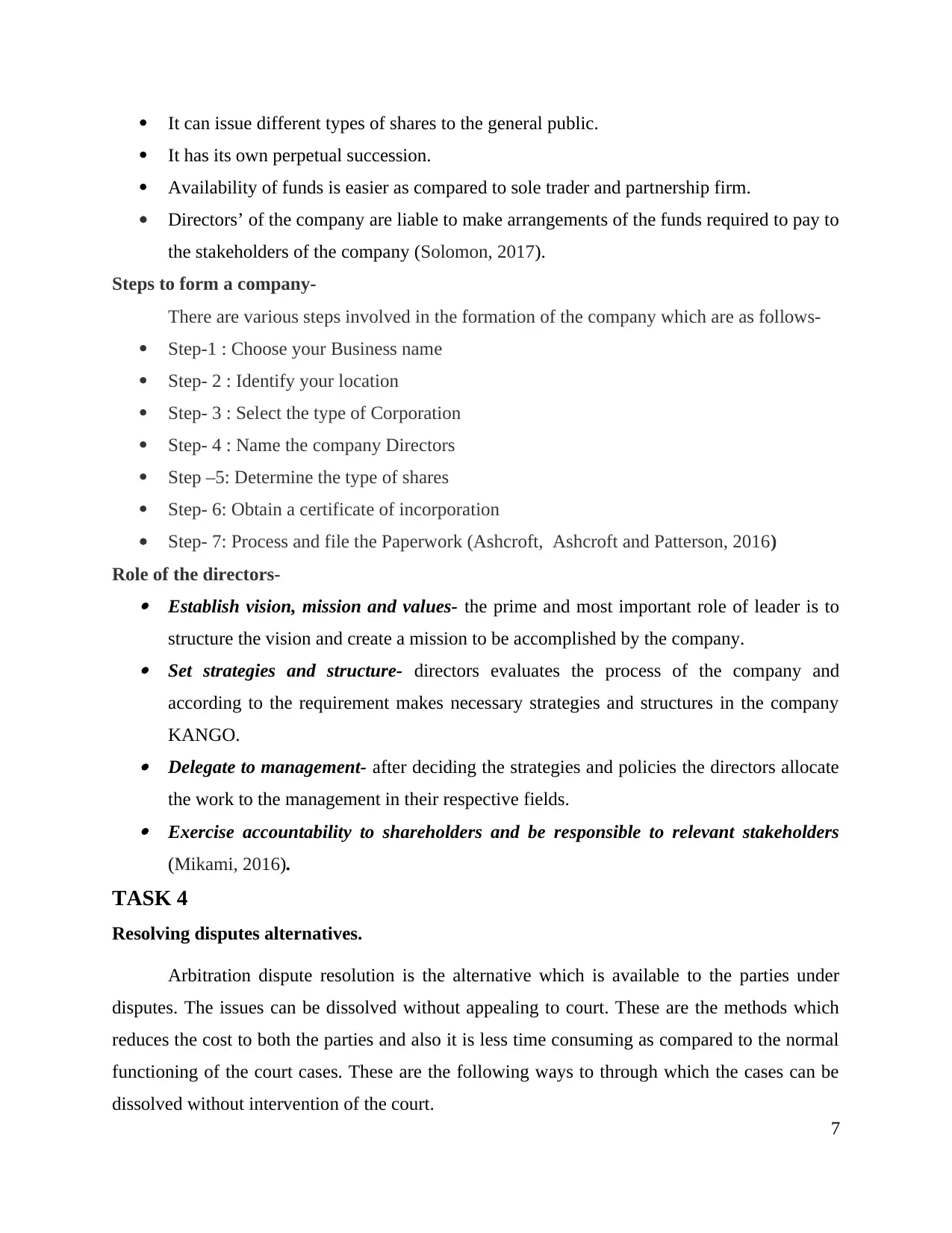
It can issue different types of shares to the general public.
It has its own perpetual succession.
Availability of funds is easier as compared to sole trader and partnership firm.
Directors’ of the company are liable to make arrangements of the funds required to pay to
the stakeholders of the company (Solomon, 2017).
Steps to form a company-
There are various steps involved in the formation of the company which are as follows-
Step-1 : Choose your Business name
Step- 2 : Identify your location
Step- 3 : Select the type of Corporation
Step- 4 : Name the company Directors
Step –5: Determine the type of shares
Step- 6: Obtain a certificate of incorporation
Step- 7: Process and file the Paperwork (Ashcroft, Ashcroft and Patterson, 2016)
Role of the directors- Establish vision, mission and values- the prime and most important role of leader is to
structure the vision and create a mission to be accomplished by the company. Set strategies and structure- directors evaluates the process of the company and
according to the requirement makes necessary strategies and structures in the company
KANGO. Delegate to management- after deciding the strategies and policies the directors allocate
the work to the management in their respective fields. Exercise accountability to shareholders and be responsible to relevant stakeholders
(Mikami, 2016).
TASK 4
Resolving disputes alternatives.
Arbitration dispute resolution is the alternative which is available to the parties under
disputes. The issues can be dissolved without appealing to court. These are the methods which
reduces the cost to both the parties and also it is less time consuming as compared to the normal
functioning of the court cases. These are the following ways to through which the cases can be
dissolved without intervention of the court.
7
It has its own perpetual succession.
Availability of funds is easier as compared to sole trader and partnership firm.
Directors’ of the company are liable to make arrangements of the funds required to pay to
the stakeholders of the company (Solomon, 2017).
Steps to form a company-
There are various steps involved in the formation of the company which are as follows-
Step-1 : Choose your Business name
Step- 2 : Identify your location
Step- 3 : Select the type of Corporation
Step- 4 : Name the company Directors
Step –5: Determine the type of shares
Step- 6: Obtain a certificate of incorporation
Step- 7: Process and file the Paperwork (Ashcroft, Ashcroft and Patterson, 2016)
Role of the directors- Establish vision, mission and values- the prime and most important role of leader is to
structure the vision and create a mission to be accomplished by the company. Set strategies and structure- directors evaluates the process of the company and
according to the requirement makes necessary strategies and structures in the company
KANGO. Delegate to management- after deciding the strategies and policies the directors allocate
the work to the management in their respective fields. Exercise accountability to shareholders and be responsible to relevant stakeholders
(Mikami, 2016).
TASK 4
Resolving disputes alternatives.
Arbitration dispute resolution is the alternative which is available to the parties under
disputes. The issues can be dissolved without appealing to court. These are the methods which
reduces the cost to both the parties and also it is less time consuming as compared to the normal
functioning of the court cases. These are the following ways to through which the cases can be
dissolved without intervention of the court.
7
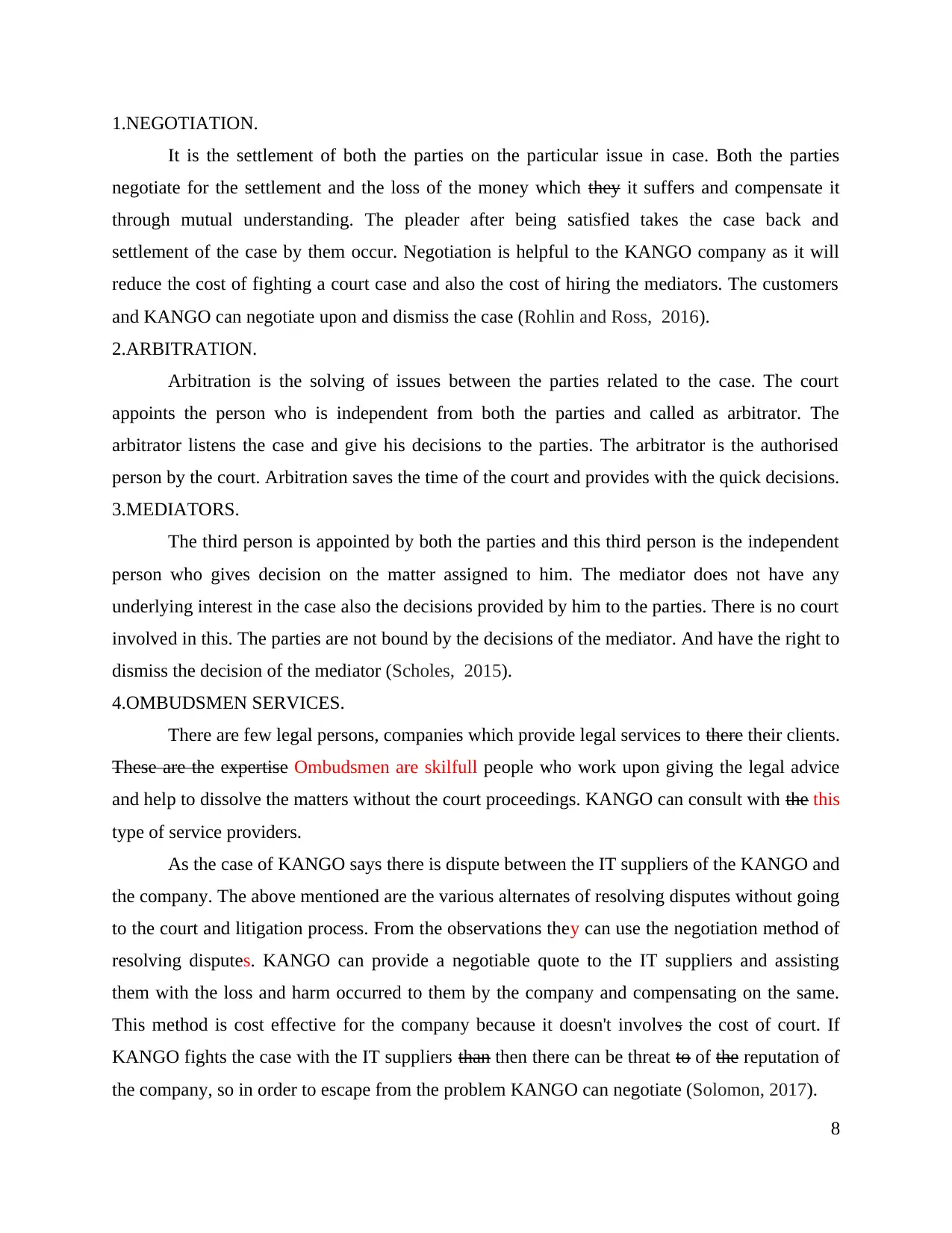
1.NEGOTIATION.
It is the settlement of both the parties on the particular issue in case. Both the parties
negotiate for the settlement and the loss of the money which they it suffers and compensate it
through mutual understanding. The pleader after being satisfied takes the case back and
settlement of the case by them occur. Negotiation is helpful to the KANGO company as it will
reduce the cost of fighting a court case and also the cost of hiring the mediators. The customers
and KANGO can negotiate upon and dismiss the case (Rohlin and Ross, 2016).
2.ARBITRATION.
Arbitration is the solving of issues between the parties related to the case. The court
appoints the person who is independent from both the parties and called as arbitrator. The
arbitrator listens the case and give his decisions to the parties. The arbitrator is the authorised
person by the court. Arbitration saves the time of the court and provides with the quick decisions.
3.MEDIATORS.
The third person is appointed by both the parties and this third person is the independent
person who gives decision on the matter assigned to him. The mediator does not have any
underlying interest in the case also the decisions provided by him to the parties. There is no court
involved in this. The parties are not bound by the decisions of the mediator. And have the right to
dismiss the decision of the mediator (Scholes, 2015).
4.OMBUDSMEN SERVICES.
There are few legal persons, companies which provide legal services to there their clients.
These are the expertise Ombudsmen are skilfull people who work upon giving the legal advice
and help to dissolve the matters without the court proceedings. KANGO can consult with the this
type of service providers.
As the case of KANGO says there is dispute between the IT suppliers of the KANGO and
the company. The above mentioned are the various alternates of resolving disputes without going
to the court and litigation process. From the observations they can use the negotiation method of
resolving disputes. KANGO can provide a negotiable quote to the IT suppliers and assisting
them with the loss and harm occurred to them by the company and compensating on the same.
This method is cost effective for the company because it doesn't involves the cost of court. If
KANGO fights the case with the IT suppliers than then there can be threat to of the reputation of
the company, so in order to escape from the problem KANGO can negotiate (Solomon, 2017).
8
It is the settlement of both the parties on the particular issue in case. Both the parties
negotiate for the settlement and the loss of the money which they it suffers and compensate it
through mutual understanding. The pleader after being satisfied takes the case back and
settlement of the case by them occur. Negotiation is helpful to the KANGO company as it will
reduce the cost of fighting a court case and also the cost of hiring the mediators. The customers
and KANGO can negotiate upon and dismiss the case (Rohlin and Ross, 2016).
2.ARBITRATION.
Arbitration is the solving of issues between the parties related to the case. The court
appoints the person who is independent from both the parties and called as arbitrator. The
arbitrator listens the case and give his decisions to the parties. The arbitrator is the authorised
person by the court. Arbitration saves the time of the court and provides with the quick decisions.
3.MEDIATORS.
The third person is appointed by both the parties and this third person is the independent
person who gives decision on the matter assigned to him. The mediator does not have any
underlying interest in the case also the decisions provided by him to the parties. There is no court
involved in this. The parties are not bound by the decisions of the mediator. And have the right to
dismiss the decision of the mediator (Scholes, 2015).
4.OMBUDSMEN SERVICES.
There are few legal persons, companies which provide legal services to there their clients.
These are the expertise Ombudsmen are skilfull people who work upon giving the legal advice
and help to dissolve the matters without the court proceedings. KANGO can consult with the this
type of service providers.
As the case of KANGO says there is dispute between the IT suppliers of the KANGO and
the company. The above mentioned are the various alternates of resolving disputes without going
to the court and litigation process. From the observations they can use the negotiation method of
resolving disputes. KANGO can provide a negotiable quote to the IT suppliers and assisting
them with the loss and harm occurred to them by the company and compensating on the same.
This method is cost effective for the company because it doesn't involves the cost of court. If
KANGO fights the case with the IT suppliers than then there can be threat to of the reputation of
the company, so in order to escape from the problem KANGO can negotiate (Solomon, 2017).
8
Secure Best Marks with AI Grader
Need help grading? Try our AI Grader for instant feedback on your assignments.
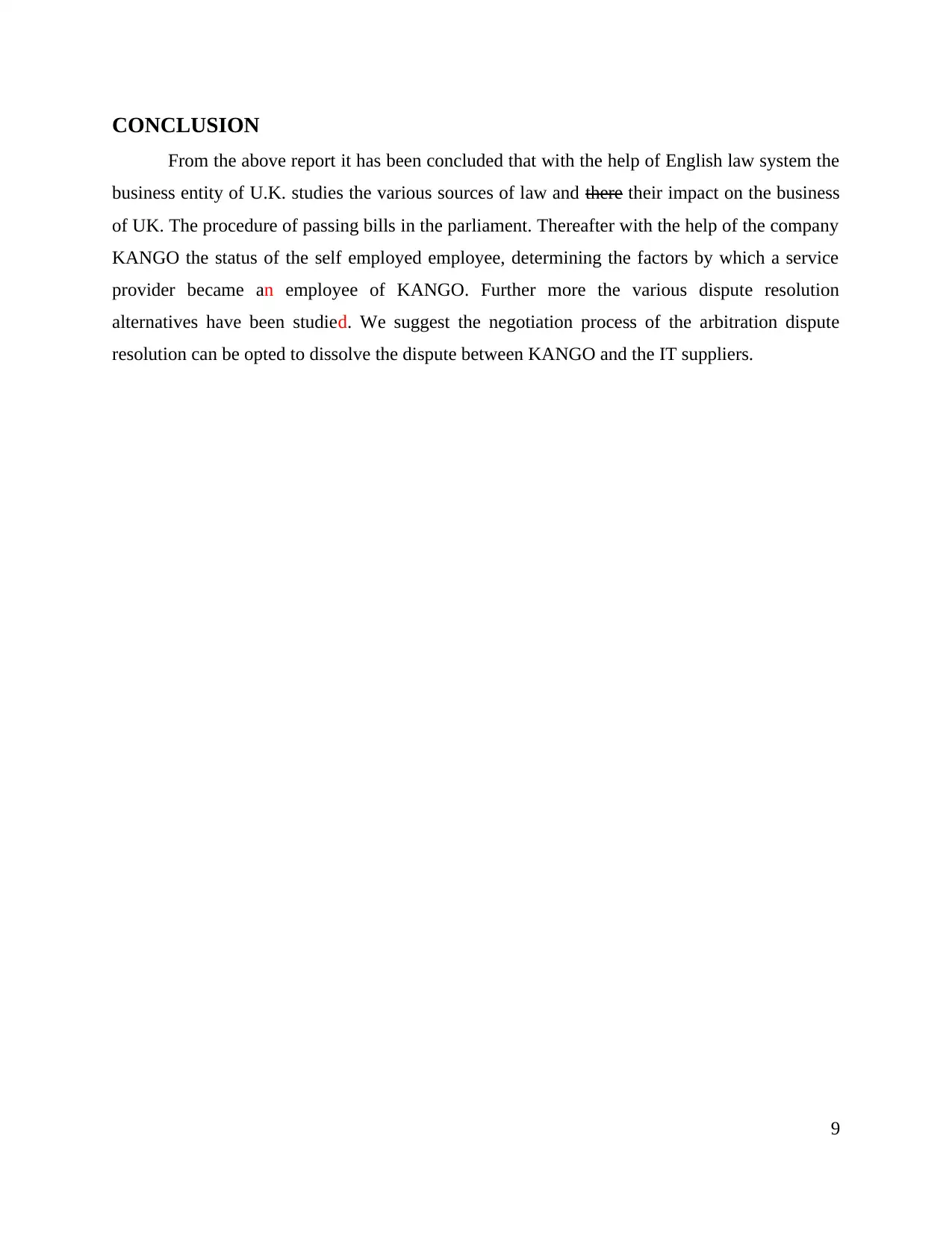
CONCLUSION
From the above report it has been concluded that with the help of English law system the
business entity of U.K. studies the various sources of law and there their impact on the business
of UK. The procedure of passing bills in the parliament. Thereafter with the help of the company
KANGO the status of the self employed employee, determining the factors by which a service
provider became an employee of KANGO. Further more the various dispute resolution
alternatives have been studied. We suggest the negotiation process of the arbitration dispute
resolution can be opted to dissolve the dispute between KANGO and the IT suppliers.
9
From the above report it has been concluded that with the help of English law system the
business entity of U.K. studies the various sources of law and there their impact on the business
of UK. The procedure of passing bills in the parliament. Thereafter with the help of the company
KANGO the status of the self employed employee, determining the factors by which a service
provider became an employee of KANGO. Further more the various dispute resolution
alternatives have been studied. We suggest the negotiation process of the arbitration dispute
resolution can be opted to dissolve the dispute between KANGO and the IT suppliers.
9

REFERENCES
Allen, W. T., 2017. Our schizophrenic conception of the business corporation. In Corporate
Governance (pp. 79-99). Gower.
Ashcroft, J. D., Ashcroft, K. and Patterson, M., 2016. Cengage Advantage Books: Law for
Business. Cengage Learning.
Bayern, S., 2016. The Implications of Modern Business–Entity Law for the Regulation of
Autonomous Systems. European Journal of Risk Regulation.7(2).pp.297-309.
Bernaz, N., 2016. Business and human rights: history, law and policy-bridging the
accountability gap. Routledge.
Cameron, E. A. and Pagnattaro, M. A., 2017. Beyond Millennials: Engaging Generation Z in
Business Law Classes. Journal of Legal Studies Education.34(2).pp.317-324.
UK Parliament, (n a) Royal assent. [ONLINE] Available at:
https://www.paliament.uk/about/how/laws/passage-bill/lords/lrds-royal-aasent/ . [Accessed
9 April 2019].
Crane, A. and Matten, D., 2016.Business ethics: Managing corporate citizenship and
sustainability in the age of globalization. Oxford University Press.
Mikami, K., 2016. Cooperatives, transferable shares, and a unified business law. Annals of
Public and Cooperative Economics.87.pp.365-390.
Persadie, N. and Ramlogan, R., 2015. Commonwealth Caribbean business law. Routledge-
Cavendish.
Rohlin, S. M. and Ross, A., 2016. Does bankruptcy law affect business turnover? Evidence from
new and existing business. Economic Inquiry.54(1).pp.361-374.
Scholes, M. S., 2015. Taxes and business strategy. Prentice Hall.
Solomon, L. D., 2017. The privatization of space exploration: Business, technology, law and
policy. Routledge.
10
Allen, W. T., 2017. Our schizophrenic conception of the business corporation. In Corporate
Governance (pp. 79-99). Gower.
Ashcroft, J. D., Ashcroft, K. and Patterson, M., 2016. Cengage Advantage Books: Law for
Business. Cengage Learning.
Bayern, S., 2016. The Implications of Modern Business–Entity Law for the Regulation of
Autonomous Systems. European Journal of Risk Regulation.7(2).pp.297-309.
Bernaz, N., 2016. Business and human rights: history, law and policy-bridging the
accountability gap. Routledge.
Cameron, E. A. and Pagnattaro, M. A., 2017. Beyond Millennials: Engaging Generation Z in
Business Law Classes. Journal of Legal Studies Education.34(2).pp.317-324.
UK Parliament, (n a) Royal assent. [ONLINE] Available at:
https://www.paliament.uk/about/how/laws/passage-bill/lords/lrds-royal-aasent/ . [Accessed
9 April 2019].
Crane, A. and Matten, D., 2016.Business ethics: Managing corporate citizenship and
sustainability in the age of globalization. Oxford University Press.
Mikami, K., 2016. Cooperatives, transferable shares, and a unified business law. Annals of
Public and Cooperative Economics.87.pp.365-390.
Persadie, N. and Ramlogan, R., 2015. Commonwealth Caribbean business law. Routledge-
Cavendish.
Rohlin, S. M. and Ross, A., 2016. Does bankruptcy law affect business turnover? Evidence from
new and existing business. Economic Inquiry.54(1).pp.361-374.
Scholes, M. S., 2015. Taxes and business strategy. Prentice Hall.
Solomon, L. D., 2017. The privatization of space exploration: Business, technology, law and
policy. Routledge.
10
1 out of 12
Related Documents
Your All-in-One AI-Powered Toolkit for Academic Success.
+13062052269
info@desklib.com
Available 24*7 on WhatsApp / Email
![[object Object]](/_next/static/media/star-bottom.7253800d.svg)
Unlock your academic potential
© 2024 | Zucol Services PVT LTD | All rights reserved.





